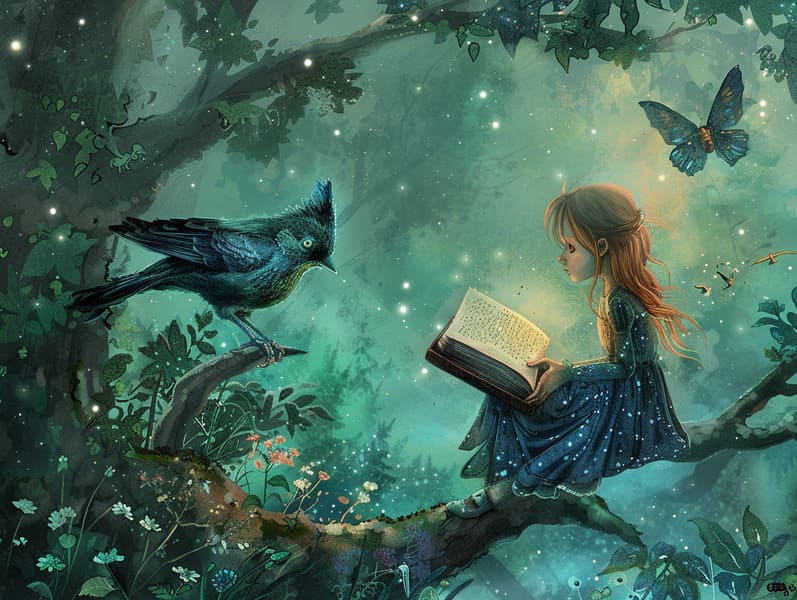The Emergence of Bedtime Fairy Tales and the Ageless Splendor.
The Emergence of Bedtime Fairy Tales and the Ageless Splendor.
Blog Article

Legendary fairy tales have long histories. These stories have been whispered from one generation to the next ages before they were ever recorded. They sprang from a variety of backgrounds, including Asian traditions. They were initially disseminated among older generations, often carrying themes and messages relevant to the societal norms and beliefs of the time.
The Grimm brothers, Jacob and Wilhelm Grimm, were among the first to collect and release many of these beloved tales. Their volume, "Grimm's Fairy Tales," included stories like "The Little Glass Slipper," "Hansel and Grethel," and "Snow-White and Rose-Red," which have since become staples in the world of classic fairy tales. Similarly, Hans Christian Andersen's imaginative stories, such as "The Mermaid's Tale," and "The Little Duckling," have captured hearts worldwide, establishing their place in the pantheon of classic fairy tales.
Despite their age, classic fairy tales remain as meaningful as ever, especially as children's night stories. These whimsical stories are now available in diverse formats, including gorgeously illustrated books, captivating animations, and free fairy tales online.
Their ongoing significance can be credited to several enchanting factors:
Moral Lessons: Classic fairy tales often provide important moral lessons. Stories like "The Shepherd Boy and the Wolf" teach the benefit of truthfulness, while "The Tortoise and the Hare" demonstrate the virtues of persistence and unpretentiousness. These stories offer young readers clear distinctions between truth and falsehood, guiding their moral compass in a soft yet impactful way.
Warmth and Understanding: Fairy tales frequently involve characters facing trials and tribulations, urging listeners to identify with their struggles and encourage their triumphs. For instance, "Beauty and Her Beast" shows us the virtue of looking beyond appearances to comprehend the inner spirit of a being, promoting tenderness and knowledge.
Cultural Appreciation: Many timeless fairy tales are steeped in the cultural contexts from which they emerged. Discovering these narratives can provide captivating looks into different cultures, encouraging a sense of world appreciation and perception.
Fantasy and Innovation: The supernatural elements in classic fairy tales—talking beasts—boost children’s creative thoughts. These fairy tales lead readers to extraordinary realms, revitalizing innovative dreams and a sense of delight that stays a lifetime.
Classic fairy tales are not only alluring but also informative. They work as captivating tools in building various mind and heart abilities in kids. When ancient fairy tales are told out loud, they develop speech development by teaching new terms and elaborate sentence structures. This practice also improves auditory skills and mindfulness, as young ones remain attentive, eager to see what happens next.
Furthermore, exploring the themes and characters of old fairy tales can nurture cognitive skills and logical thinking. Little ones are taught to pinpoint patterns, foresee events, and understand cause and effect. These contemplations also further children communicate their thoughts and feelings, contributing to their emotional intelligence.
In today’s cyber age, the prevalence of digital fairy tales has made these narratives more available than ever. Internet sites and applications extend large libraries of bedtime fairy tales that can be explored or listened through anytime, anywhere. Fairy tales told out loud are particularly common, featuring an charming way for little ones to enjoy these fascinating tales. Read-aloud books and narrated videos lead characters and settings to life, often supported by bewitching sound effects and music that enrich the story journey.
The timeless fascination of traditional fairy tales lies in their ability to alter to present eras while sustaining their main lessons. Contemporary takes of these fairy tales often integrate more multicultural protagonists and modern settings, making them meaningful to today’s audience. However, the basic principles of braveness, kindness, and fairness remain unchanged, continuing to move young readers of all ages.
Old fairy tales also offer a sense of warmth and knownness. They make available a structured narrative with a unmistakable beginning, middle, and end, often drawing to a close with the conclusion of conflicts and the triumph of good over bad. This foreseeability can be soothing for little ones, distributing a sense of solidity in an ever-changing world.
Classic fairy tales continue to entrance and enlighten new generations, maintaining their mystique and significance in modern society. As children's bedtime stories, they supply a perfect blend of delight and instruction, promoting moral values, empathy, and creativity. The proliferation of web-based fairy tales and the likability of fairy tales read aloud secure that these ancient tales remain available to new generations.
By protecting and releasing these tales, we continue to esteem the rich tapestry of mythology and cultural heritage. Whether you are accessing a vividly illustrated book, seeing a online collection, or listening to an read-aloud book, the captivation of timeless fairy tales is always within reach. These fairy tales highlight of the continued presence of stories and its ability to unite us across epochs and places.
Regardless if you are experiencing a gorgeously illustrated book, perusing a web-based library, or listening via an audio story, the enchantment of popular fairy tales is always within reach.
These narratives point out of the invariable force of storytelling and its ability to bond us across eras and this site regions, creating a bond that enchants and educates alike.